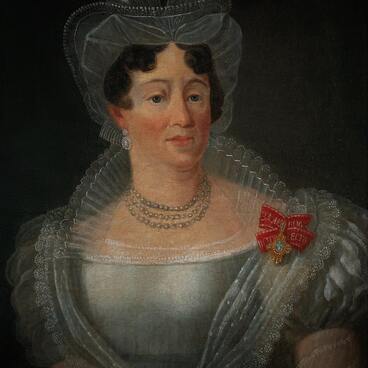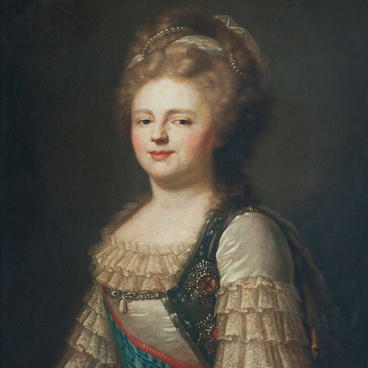In the first half of the 19th century, portraits began to be commissioned not only by the royal family and the highest nobility but also by representatives of the middle class — the urban bourgeoisie, the Russian merchants and the petty bourgeoisie. These works of art were created rather for the memory of posterity. To this day, many such canvases have come down anonymous: not only the author is unknown, but also the names of those depicted. Still, the artists, whose names have not survived, provided detailed portraits of people with average incomes that give an idea of their everyday life. The collection of the Old Mansion presents “Portrait of a Young Woman in a Striped Dress with a Kolokoltsov’s Shawl”. It was painted in the early 19th century.
The time of the creation of the portrait was determined by the cut of the dress, the nature of its decoration, jewelry and hairstyle of the model, as well as by a shawl draped over her shoulders. In the late 18th — early 19th centuries, in imitation of French fashion, an “antique” female costume appeared in Russia, which was partly due to the French portrait painter Élisabeth Vigée Le Brun, who lived in St. Petersburg from 1795 to 1801. On her advice, at one of the court balls, all the ladies dressed in white “antique” dresses. Soon this fashion was picked up in houses with more modest means. The dress designs were often named after Roman goddesses: Venus, Diana, Minerva. The high-waisted dresses were sewn from free flowing fabric.
In the cold season, women in such outfits would freeze. Many women of fashion were often sick, and some died from colds. But soon the ladies found a way out: shawls were thrown over the dress. In summer, preference was given to lightweight fabrics, and in winter — woolen fabrics.
In Russia, exquisite Kolokoltsov’s shawls were especially fashionable. They got named after the owners of the workshops where they were produced. Made in the technique of double-sided weaving, these products had the same finish on the front and back sides. Only wealthy customers could afford them. The artist depicted such a shawl in the Arkhangelsk portrait. The painting entered the museum in 1985 from a private St. Petersburg collection. In 1995, it was restored at the All-Russian Art Scientific and Restoration Center named after academician Igor Grabar.
The time of the creation of the portrait was determined by the cut of the dress, the nature of its decoration, jewelry and hairstyle of the model, as well as by a shawl draped over her shoulders. In the late 18th — early 19th centuries, in imitation of French fashion, an “antique” female costume appeared in Russia, which was partly due to the French portrait painter Élisabeth Vigée Le Brun, who lived in St. Petersburg from 1795 to 1801. On her advice, at one of the court balls, all the ladies dressed in white “antique” dresses. Soon this fashion was picked up in houses with more modest means. The dress designs were often named after Roman goddesses: Venus, Diana, Minerva. The high-waisted dresses were sewn from free flowing fabric.
In the cold season, women in such outfits would freeze. Many women of fashion were often sick, and some died from colds. But soon the ladies found a way out: shawls were thrown over the dress. In summer, preference was given to lightweight fabrics, and in winter — woolen fabrics.
In Russia, exquisite Kolokoltsov’s shawls were especially fashionable. They got named after the owners of the workshops where they were produced. Made in the technique of double-sided weaving, these products had the same finish on the front and back sides. Only wealthy customers could afford them. The artist depicted such a shawl in the Arkhangelsk portrait. The painting entered the museum in 1985 from a private St. Petersburg collection. In 1995, it was restored at the All-Russian Art Scientific and Restoration Center named after academician Igor Grabar.



